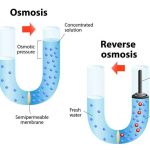Frequently several minerals are involved in a given water problem.
Hardness
Water hardness above 5 grains is considered for treatment. Hardness is calcium and magnesium which tends to revert back to the solid state when water is heated. This solid material will form scale and will also combine with chemicals added to water such as detergents. The higher the hardness, the faster scale will form or the “harder” it is to produce suds for good cleaning action.
High hardness (10 grains and above) will shorten the life of water heaters, electric heating elements, and water using appliances.
A water softener removes the hardness minerals from water and replaces it with sodium which is an inert mineral. Sodium readily dissolves in water; it has a high solubility which means it will stay in solution unlike the hardness minerals. The source of sodium for regeneration of a softener is (sodium chloride). A softener’s capacity is based on how much sodium the resin will retain and what that represents in grains of hardness removed by ion exchange.
A water softener will also exchange (remove) other metallic ions in solution such as iron, manganese, copper, etc. These ions must be dissolved in the water for complete removal. Oxidized iron will pass directly through the softener.
Iron (0.30 ppm will stain)
Stains fixtures and clothing red/brown. Unstable in water when water is exposed to oxygen. Yellow water indicates that part, or all of the iron, has oxidized and will precipitate out of the water.
Dissolved Iron is indicated when water drawn at tap is clear but turns yellow upon standing. A water softener will remove this “clear water” iron.
Oxidized Iron is indicated by yellow color as soon as water is drawn from tap. A sediment filter will remove this iron, but should be followed by a softener to remove iron still in solution. If iron removal only is desired, a manganese greensand (ML-FFE) filter will remove both oxidized and dissolved iron.
CAUTION: Greensand should not be used on waters where pH is below 6.8.
Iron Bacteria is indicated when water pressure diminishes and iron stains are present. Lift toilet tank cover to confirm; slimy, stringy, brown growth is iron bacteria. This is most difficult form of iron and is caused by harmless bacterial that live in the absence of oxygen and feed on iron in water. It will eventually plug plumbing lines to reduce flow. Chlorinating well periodically may control growth. Best treatment is continuous chlorination followed by activated carbon filtration (ML-ACF). Optional treatment for lesser cases is the installation of a large diameter manual sediment filter (18KF-AG) to provide a “home” for them to grow.
Manganese (0.20 ppm will stain)
Similar to iron but difficult to oxidize; causes dark brown to black stains. Is frequently present with iron, but in lesser amounts. Best removal method is with water softener.
Hydrogen Sulfide (rotten egg odor)
Caused by decayed vegetation; is most troublesome due to bad odor and will cause corrosion; hydrogen lowers pH.
Hydrogen sulfide is sometimes present with iron and/or manganese. It will then cause black sticky precipitate which stains everything. Removal can be accomplished with a manganese greensand filter (up to 2 ppm H2S) or chlorination using a chemical pump, retention tank, and followed by an activated carbon filter. The latter method is used when the H2S is above 2 ppm or is accompanied by iron and low pH. A combination of chlorine and acid neutralizer is fed to adjust pH, oxidize the sulphur and iron in one operation.
Hydrogen sulfide is a gas and must be tested for at the job site to determine total H2S level.
Low pH
Acidic condition (6.8 down to 5.0 pH) will corrode plumbing, erode porcelain, and put copper or iron in water depending upon type of plumbing. Stains will be blue/green for copper and red/brown for iron. Adjustment of pH from 6.9 down to 6.5 can be done with an acid neutralizer filter (ML-ANF) which contains calcium carbonate (marble chips) media which slowly dissolves. Requires addition of more media about every two years depending upon pH level. Lower pH must be adjusted by feeding MAN-607 to the water with a chemical feed pump.
Nitrates, Sulfates, Chlorides (Anions)
EPA or U.S. Public Health Service limits on the nitrate level permissible is 44 ppm as nitrate or 10 ppm as the nitrogen ion. Nitrate causes what is known as “blue babies” due to oxygen starvation (this can occur at 25 ppm nitrate). Nitrate presence is also an indicator of organic contamination.
Sulfates cause an astringent taste in the water. Concentrations of 30 gpg can have a laxative effect due to calcium sulfate.
Chlorides can combine with natural sodium or sodium produced by softening and result in salty tasting water. Both sulfates and chlorides, as well as nitrates, are most economically removed by reverse osmosis.


